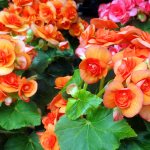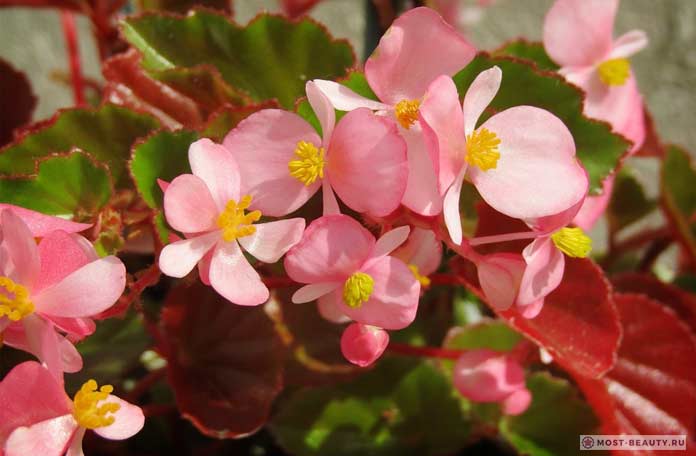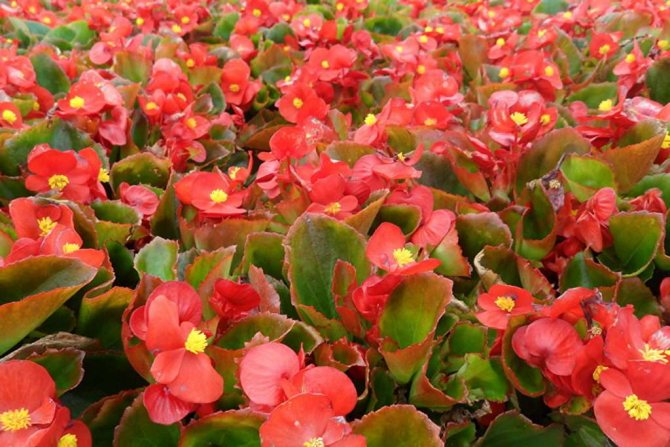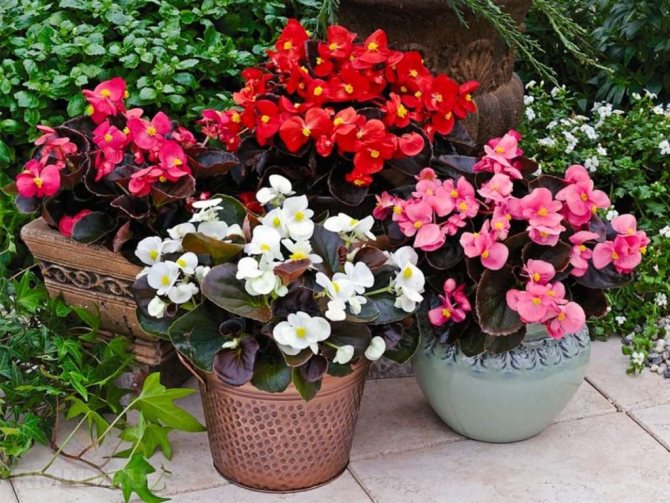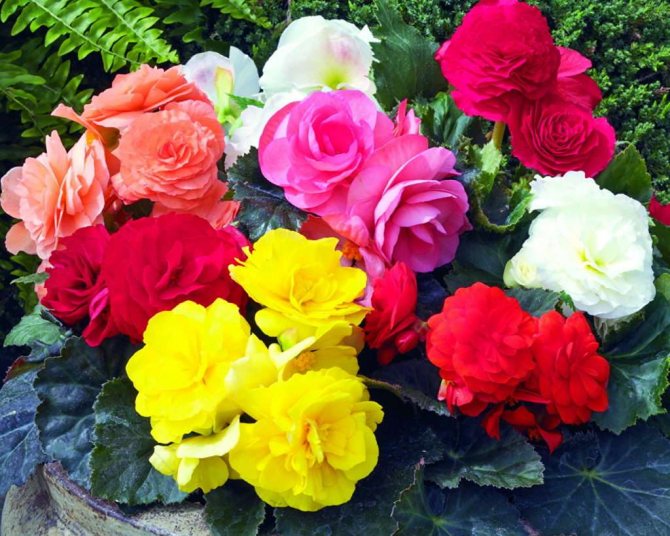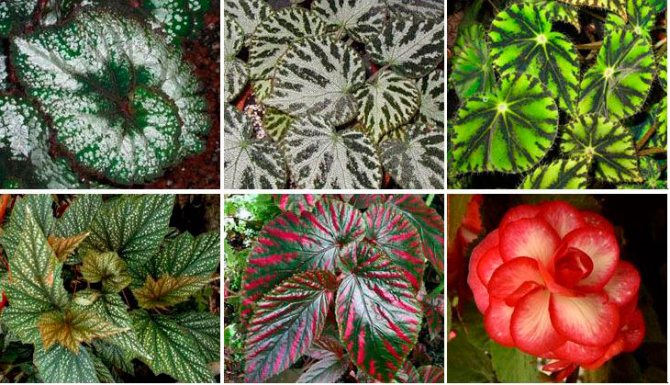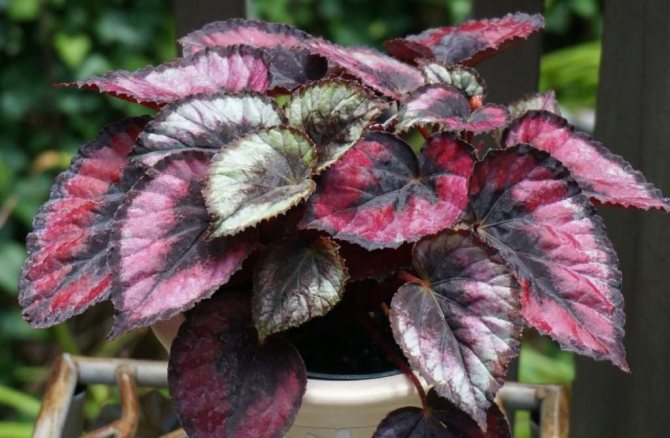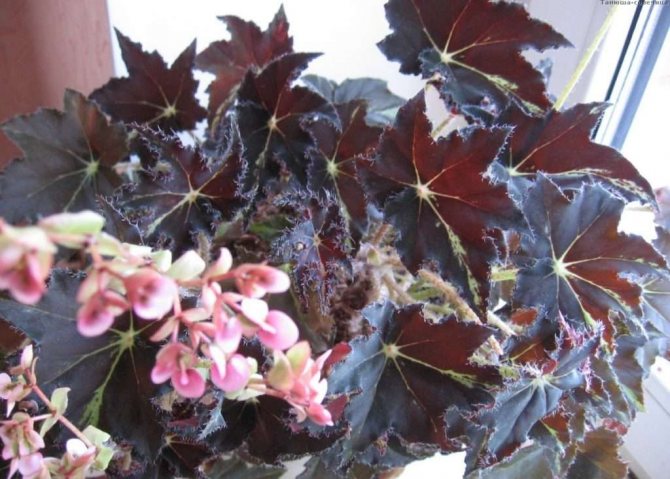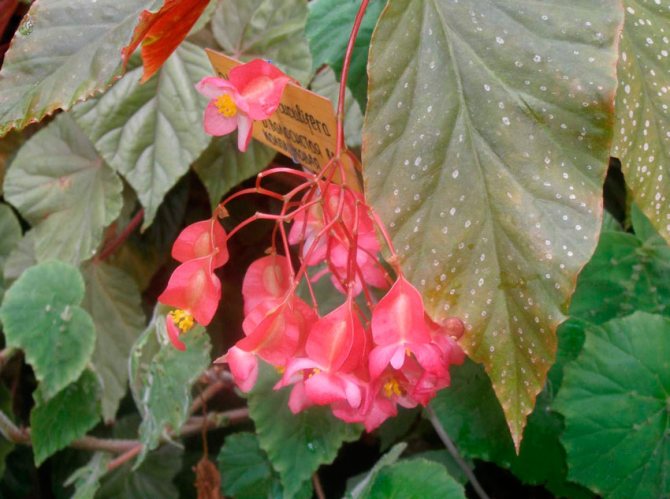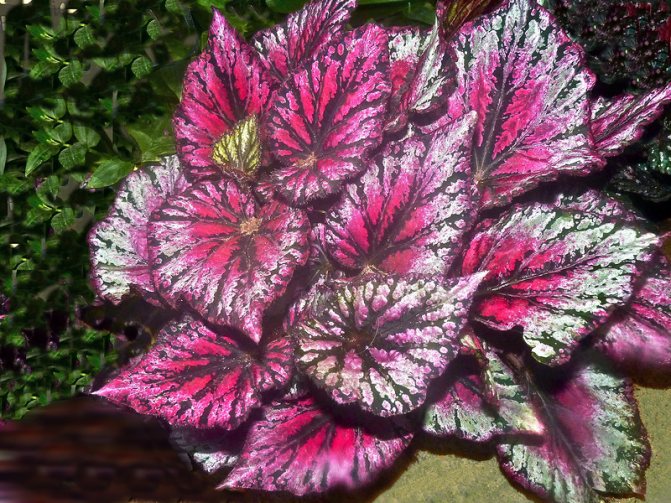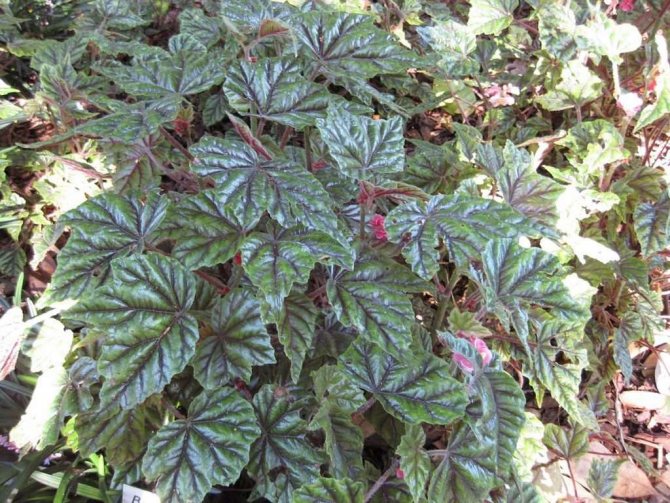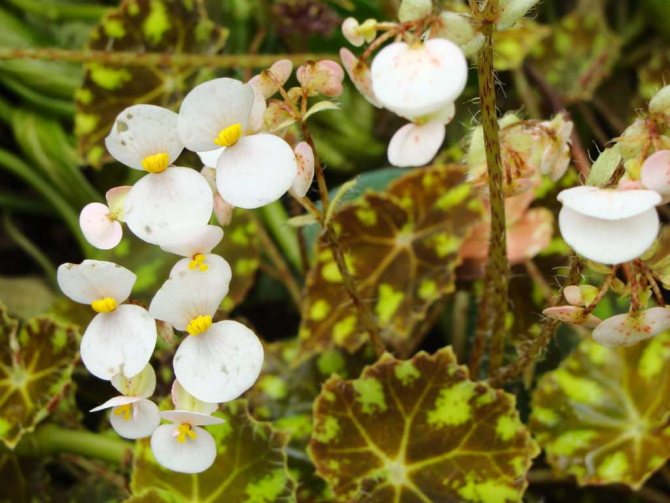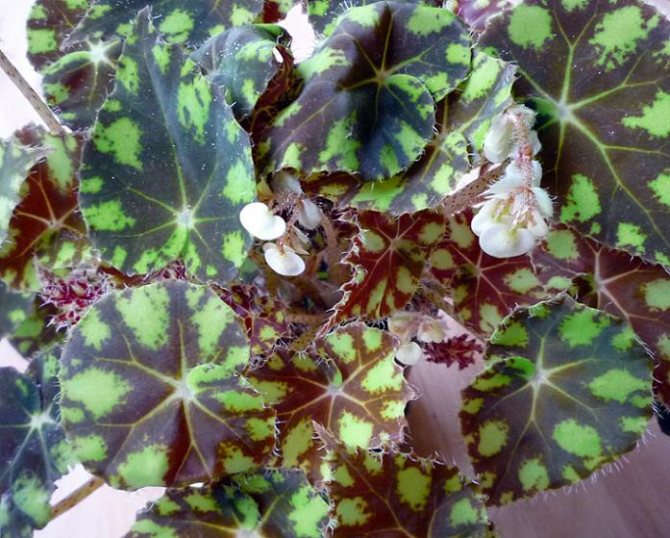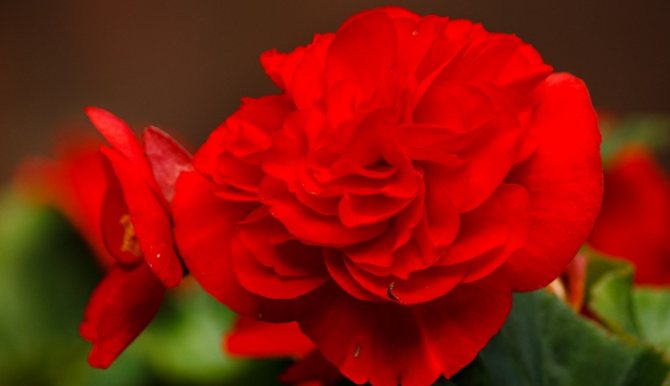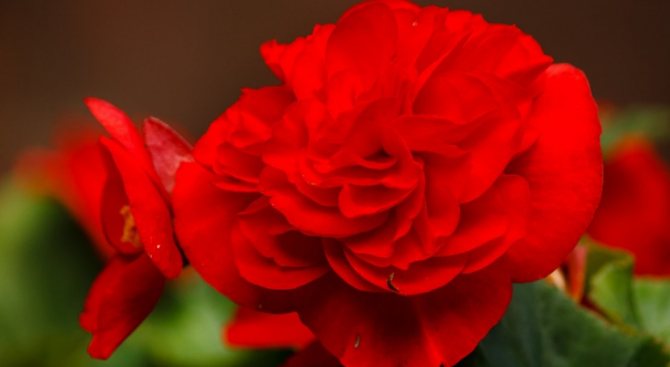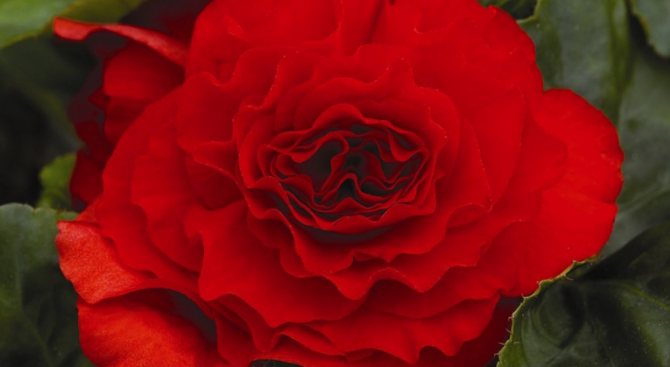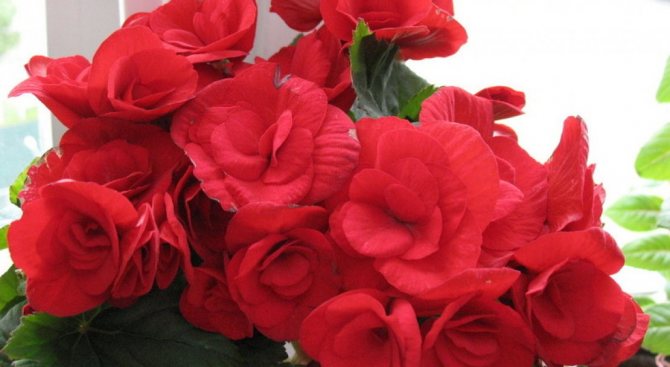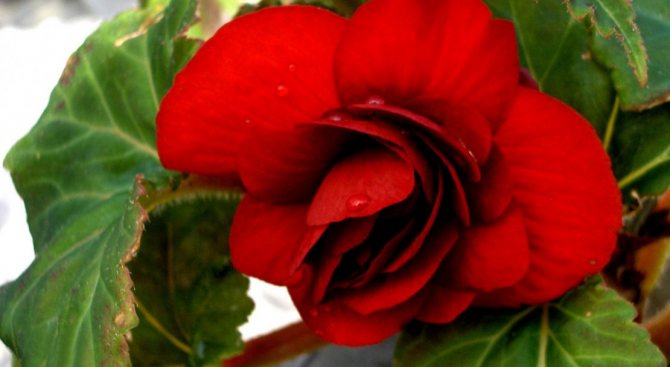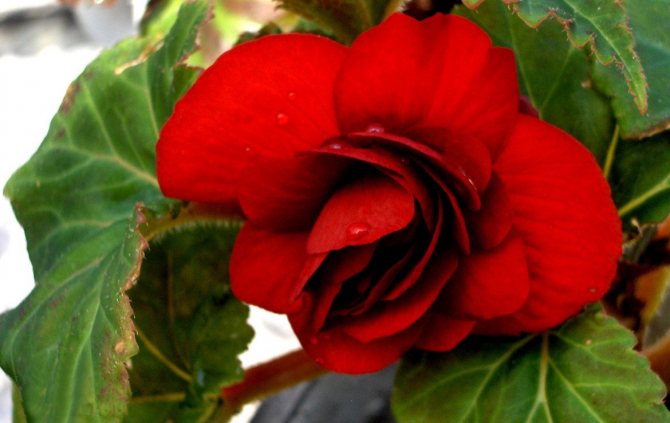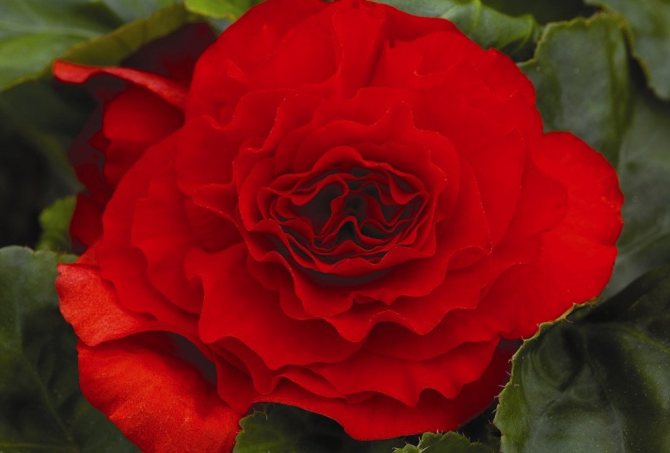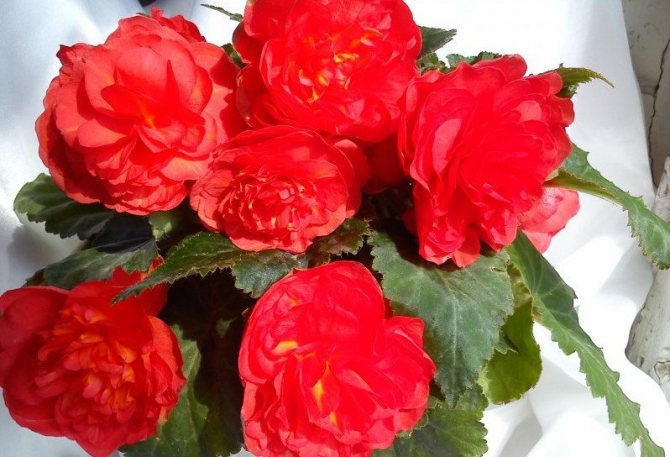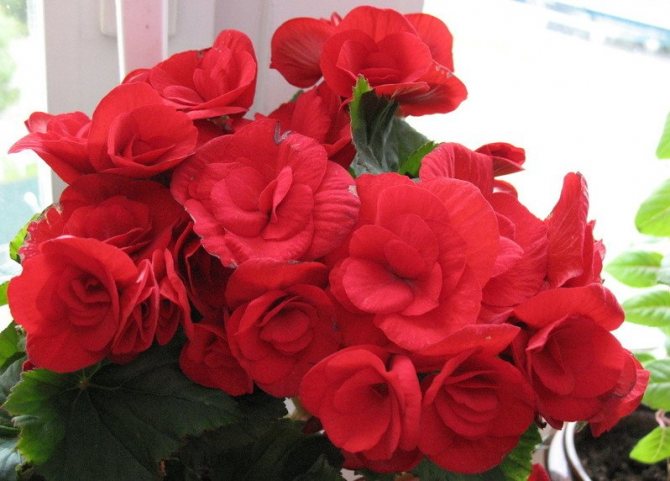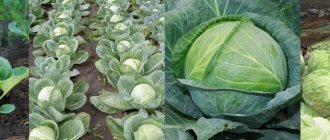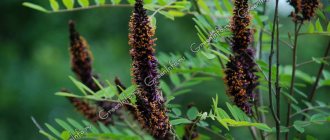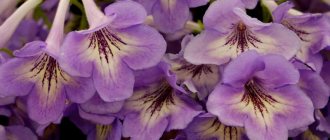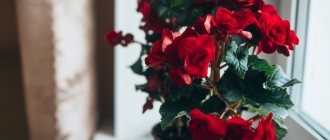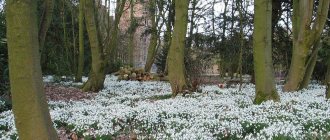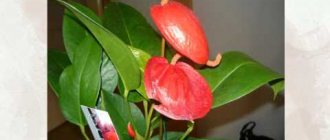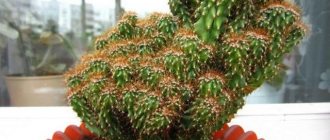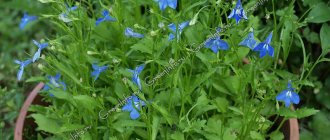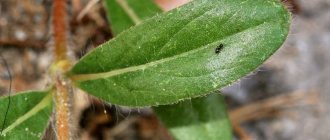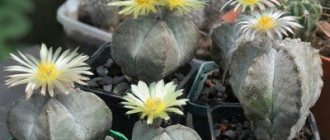It's time to get acquainted with the large group of decorative flowering begonias that can be grown indoors. As a rule, flowering begonias are complex hybrids created by breeders of different countries and generations from the most interesting species of natural and cultivated begonias. The varieties that bloom all year round are very popular. Hybrids are especially appreciated, the double inflorescences of which are similar to peonies or roses. But small bright flowers, strewn with their inflorescences, compact lush bushes or ampelous shoots throughout the year are no less popular.
Decorative deciduous
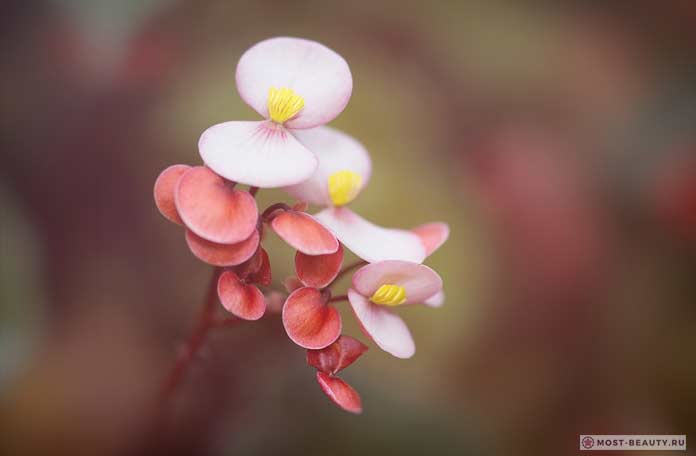
These varieties lack an aerial stem, and beautiful elongated leaves with a fringe grow directly from the root. This variety impresses with its amazing color of leaves: from standard green to red and silver. The presence of spots and edging on the leaves also adds to the attractiveness of the plant.
Rex or royal begonia


This is one of the brightest representatives of the beautiful flowers of this group of varieties. Elongated oval leaves with jagged edges impress with their variegated color - from pink to purple and violet. But even more attention is drawn to their colorful border along the edge - a contrasting silver or green shade.
Metallica
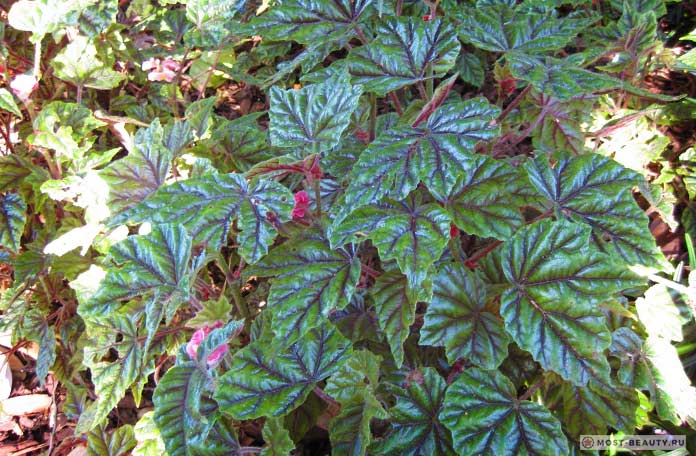

This variety received such a sonorous name for the characteristic appearance of the upper part of the leaves, which seem to be covered with a metal coating. The small leaves are olive-colored and have tiny denticles at the edges, which, in combination with their glossy sheen, gives the flower a particularly colorful look.
Bauer's begonia or tiger
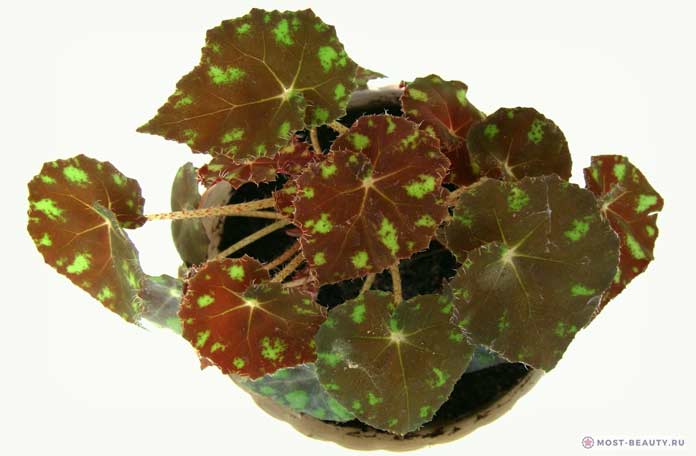

This beautiful decorative leafy begonia attracts with its original color of leaves. It is for their specific spotted color, reminiscent of a tiger skin, that it got its name. The leaves of this variety are small toothed, heart-shaped, painted in a dark green color and possessing characteristic specks.
The unique coloring and patterns of the drawing on the leaves of each individual plant of this species allow you to collect an amazing collection of flowers of the same variety, which are very different from each other. It is important to find the ideal place in the house to place the flower (neither in the shade nor in the sun) so that the Bauer's begonia leaf retains its decorative appeal and does not fade its pattern. The plant should be watered frequently, but not overfilled.
Mason's variety
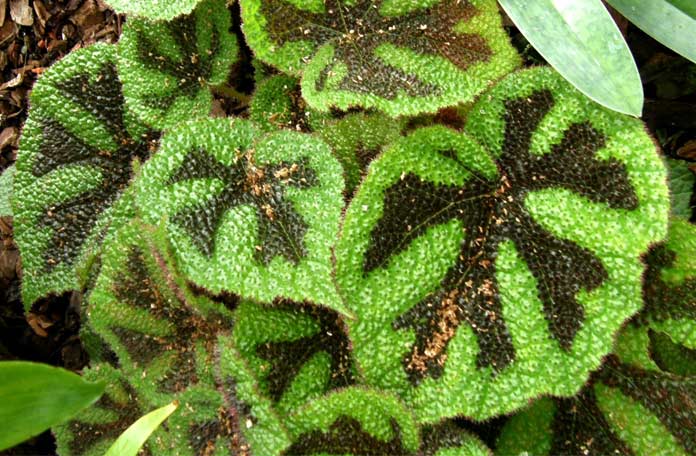

This deciduous variety is found in the wild in the forests of New Guinea. Growers appreciate this variety for the unique pattern on its leaves, which is very similar to the Maltese cross. A pattern of dark or brown color stands out contrastingly on the leaves of a light green color, which in old plants can acquire a silvery hue. This variety also pleases with small pastel flowers.
Cleopatra
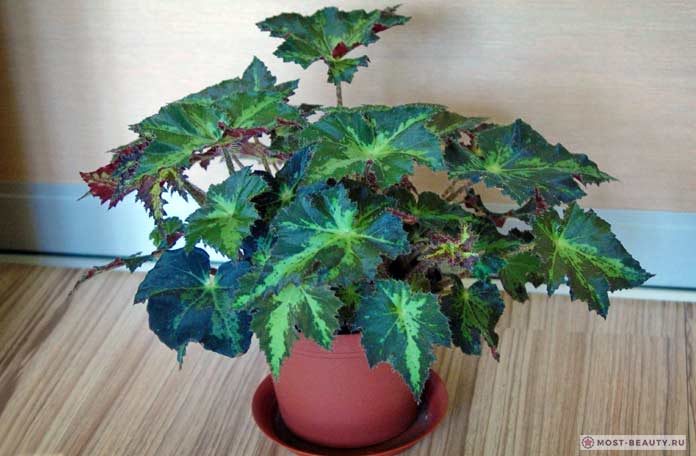

This variety attracts connoisseurs of beautiful begonias with incredibly decorative leaves that resemble maple leaves. The upper part of them is painted in bright green or olive, and the lower part surprises with contrasting burgundy or crimson shades. The presence of large elongated cuttings with silvery fibers is also characteristic of the variety. The height of such a decorative bush in a pot can reach up to 30 (less often - 50 cm). Flowers of white and pink color delight with colorful flowering in winter.
Collar or cuff
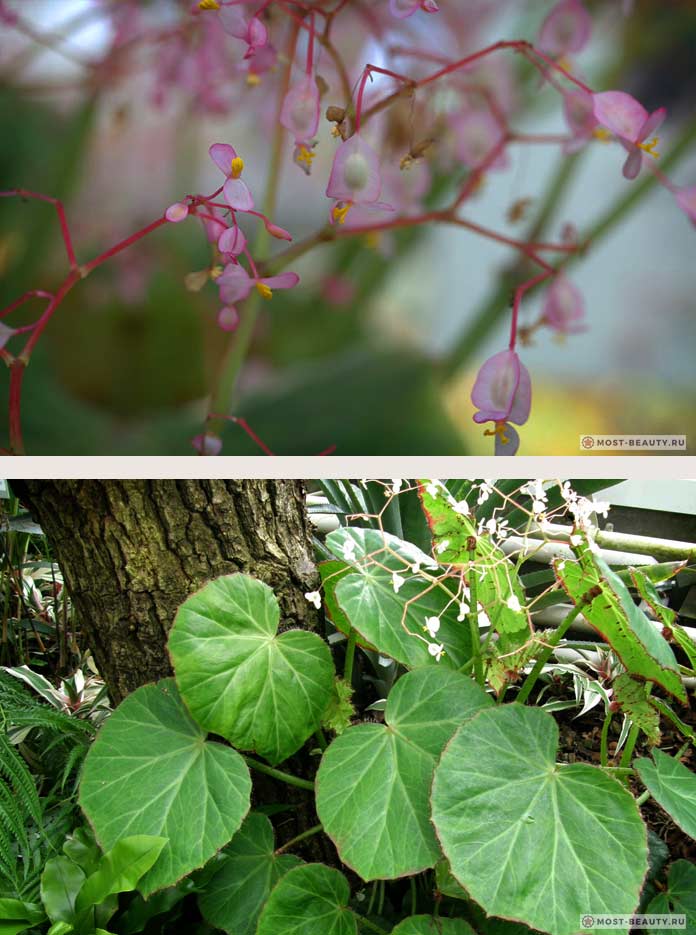

This beautiful deciduous variety impresses with its large, light green leaves on long cuttings bordered by a cuff of red villi. In winter, the plant also pleases the eye with the colorful flowering of bright pink flowers.
2
Ornamental-leaved begonias (Rhizomatous Begonias)
Deciduous group (decorative deciduous) - herbaceous species with a thick fleshy stem; asymmetrical and beautifully colored leaves grow from a creeping rhizome (rhizome).
Types of indoor begonias belonging to the "Rhizomatous" - a group of decorative leafy (rhizome, rhizomatous):
Begonia rex (hybrids) - allocated in a separate group.
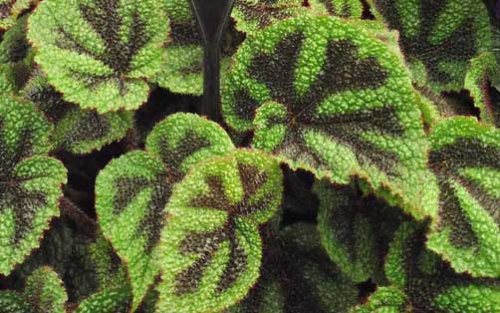

In the photo Begonia Mason (Maltese cross) - light green velvety with a pimply texture, rounded-angular asymmetric leaves in the form, in the center a brown pattern resembling a cross. With age, the general background of the leaves becomes silvery.
Begonia ‘Iron Cross’ (‘Iron Cross’) - bright green velvety leaves are oval-heart-shaped, with a brown cross in the center. Growth up to 45 cm.
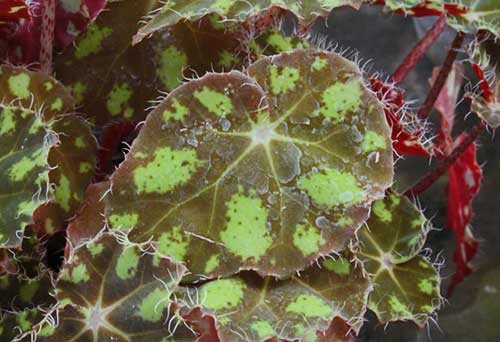

Begonia Bowerae is distinguished by a tiger pattern on dark green leaf plates and the presence of white or pink flowers.
Types of begonias: Fista (red-leaved), Bowerae (tiger bauer), diadema (hybrids), imperialis (imperial), Masoniana (Mason), heracleifolia (hogweed); collar (cuff); B. alba-picta (simultaneously referred to the 2nd group) ...
Begonia: acetosa, conchifolia, deliciosa, soli-mutata, carrieae, nelumbiifolia, macdougalii, manicata, ‘Erythrophylla’, ‘Cleopatra’ name from Begonia bowerae ...
Rhizome begonias range in size from tiny and diminutive to the likes of ‘Freddie’ (B. manicata ‘Aureo-maculata x B. barkeri) - which can even have 90 cm leaves under particularly optimal conditions.
Hybrids: 'Black Adder', 'Precious Patti', 'Robert Shatzer', 'Black Raspberry' (B. acetosa x B. imperialis), 'Cleopatra', 'Madame Queen', 'Connee Boswell', 'Charles Jaros', 'Wanda' ...
Rhizome - rhizome (English), the word itself comes from the Greek. rhiza is the root. A creeping root-like underground stem, in other words, a rhizome or rhizome, which performs the functions of vegetative renewal, reproduction. As soon as their stem touches the ground, new roots appear at the point of contact. Most domestic species form compact bushes.
Bush varieties
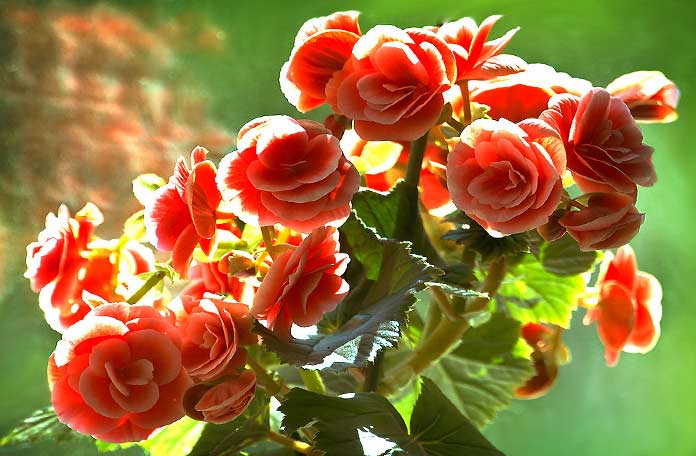

These include begonias, which are beautiful lush bushes with many side shoots. Their stems are dense and branched, like bamboo. The height of the bush can reach from 10 cm to 2 m. The leaves can be of the most different shapes and colors, and the flowers are impressive with their colorful color and elegance. These bushes can bloom all year round.
Coral begonia
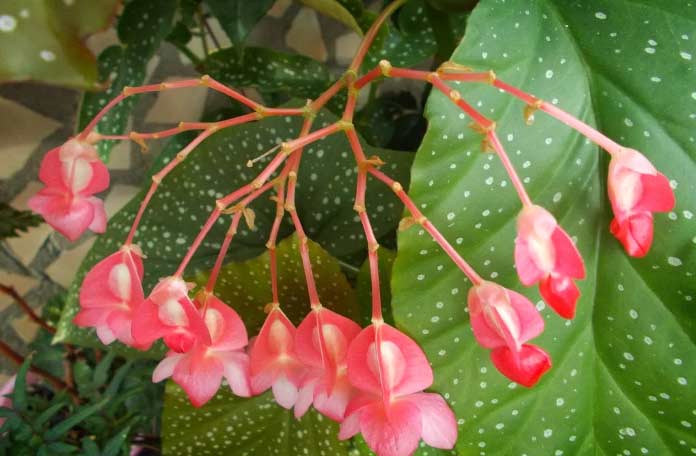

This bush variety, native to the tropics of Brazil, is most popular among flower growers because of the especially colorful color of the leaves and flowers. The oblong leaves are painted dark green on top and impress with numerous silvery dots. On the reverse side, they are brownish-red. During the flowering period, these beautiful begonias are especially beautiful. They delight the eye with numerous dense inflorescences with an abundance of small pink flowers.
Fuchsia-shaped or multi-leaved
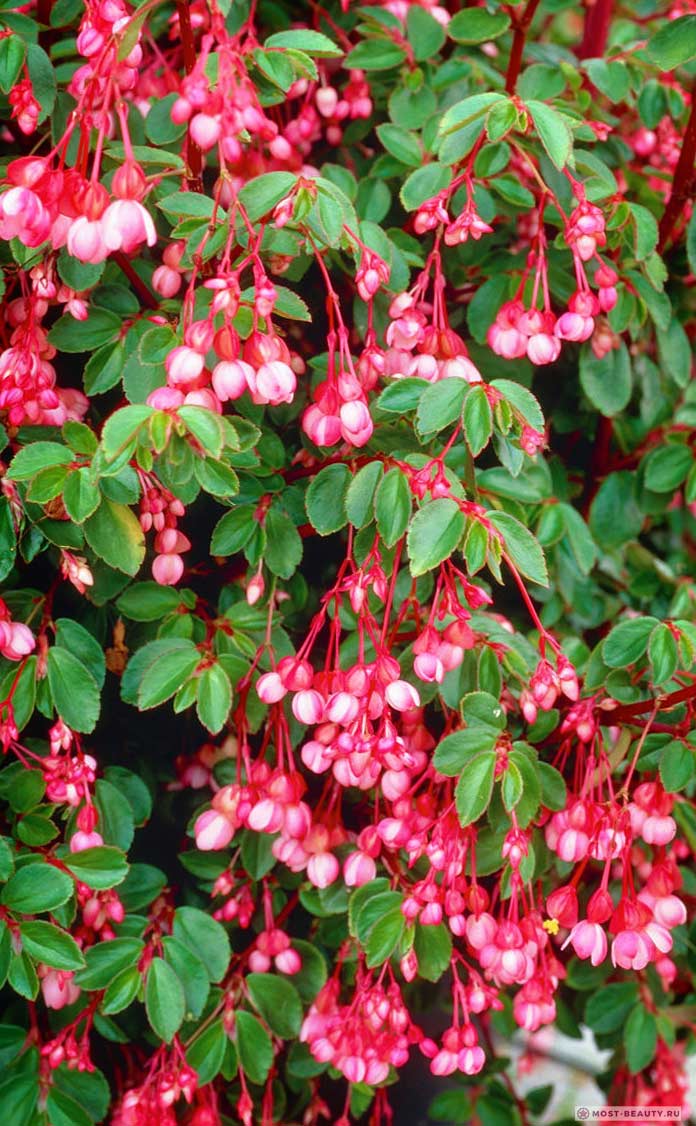

This shrub begonia, native to the tropics of Colombia, has highly branching stems, often reaching 1 m. The oval-shaped leaves have slightly jagged edges and impress with a glossy surface, most often painted in emerald hues. The plant is especially beautiful during the flowering period, when colorful flowers resembling fuchsia, painted in bright red shades, appear.
3
Description and characteristics of the plant
Begonia red is a perennial decorative and flowering tuberous plant of the Begoniev family, a feature of which is considered to be beautiful, large flowers of a rich red color. The flowers of the culture, with a diameter of about 10 cm, consist of very delicate, slightly corrugated petals. Their aroma is delicate and sweetish.
Did you know? The asteroid (943) Begonia, discovered in 1920, is named after the begonia plant.
In a home, begonia can reach a height of 20-40 cm.The leaves of a houseplant are fragile, patterned, dark green in color, harmoniously combined with large, voluminous flowers. The flowering culture lasts for several months, from May to October, while the flowering of each peduncle is 2-3 weeks. The root system is presented in the form of medium-sized tubers and thin root processes extending from them.
Tuber varieties
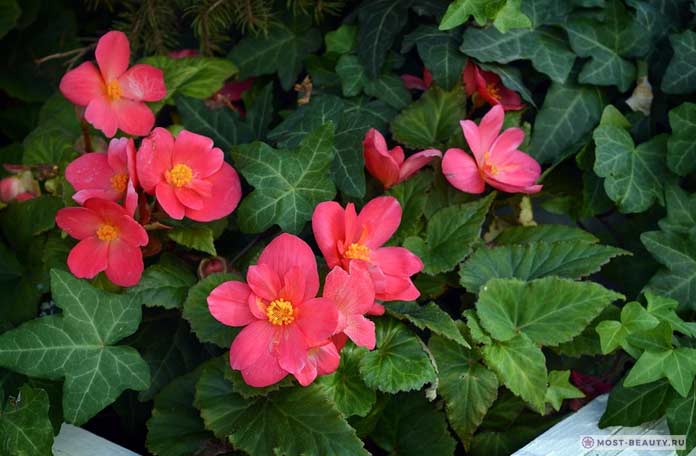

Looking at the flowers of these begonias, one might involuntarily think that they are close relatives of a camellia, a carnation or a rose - the similarity is so great. Their heart-shaped leaves are usually colored in various shades of green. These flowers delight with the longest flowering, from May to mid-autumn.
Begonia ampelous
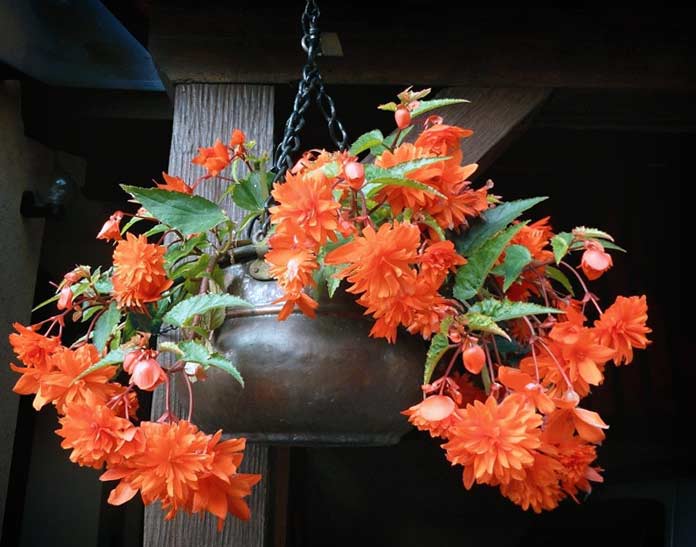

Representatives of this variety are distinguished by long stems, cascading cascades and decorated with numerous bright flowers. Most often they are grown in hanging pots, creating original floral decorations on the balcony. Especially popular varieties of this group with double flowers - "Roxana" (orange color) and "Christie" (snow-white buds).
Bolivian begonia
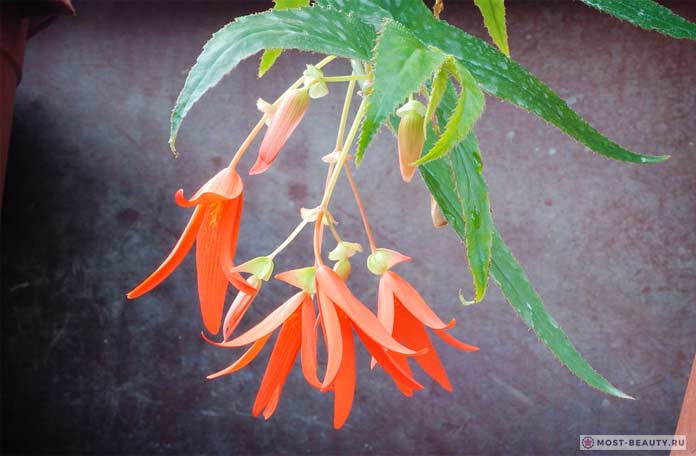

In this plant, shoots up to 30 cm grow in a straight line, and then form falling cascades in several tiers of beautiful inflorescences. Santa Cruz Sunset attracts the eye with its red and orange hues. Copacabana is a creeping plant that attracts with its colorful bell-shaped flowers, usually red in color.
Bouton de Rose
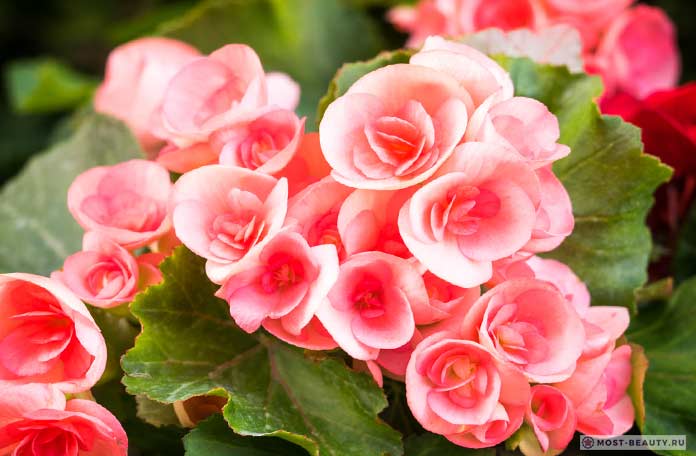

This variety is characterized by small compact bushes, decorated with large snow-white double flowers. The beautiful pink edging along the edges gives them a special beauty. The petals in the center are collected in the likeness of a rosebud, which is why they are named.
Crispa Marginata
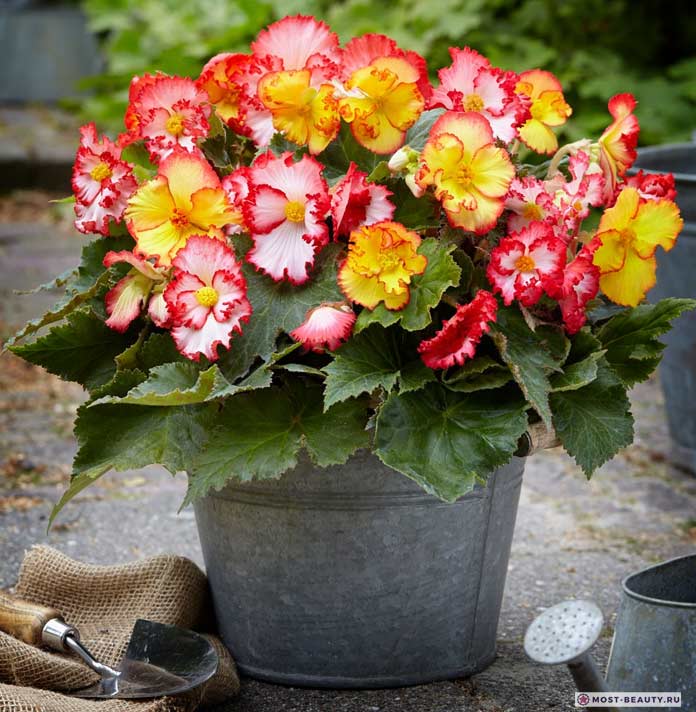

This tuberous begonia in the garden is a favorite of gardeners. Beautiful bushes with green leaves with a purple border can be grown both in a flower bed and in pots in the house. During the flowering period, this variety pleases with colorful lush white or yellow flowers with a pink or red border, which have a light sweet aroma.
Fimbriata pink
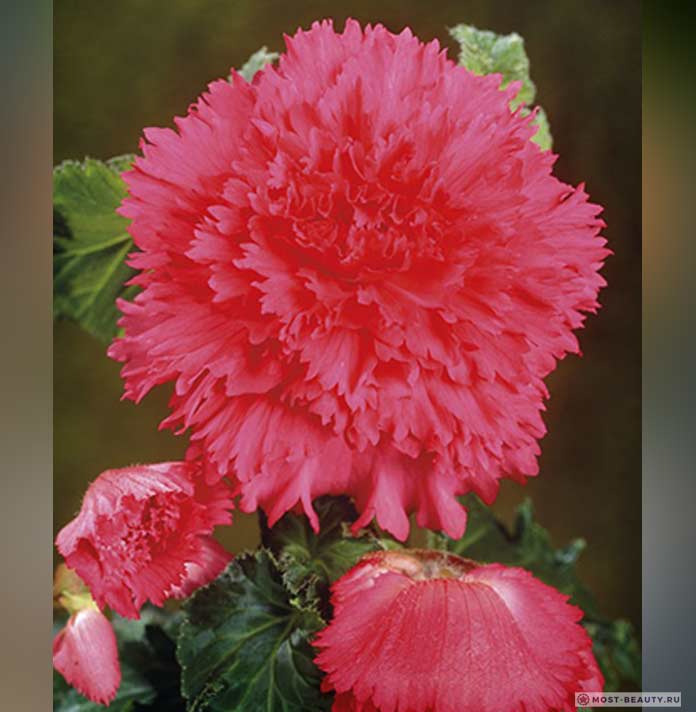

Lush flowers of a pale pink hue in this variety are very reminiscent of a carnation. Flowers have a pleasant fragrant aroma, which is very rare for the tuberous varieties of this plant. Fimbriata pink looks great in hanging pots on balconies. You can plant this kind of begonia in the open field. But it is worth remembering that this plant is very fragile and must be protected from the winds.
Bellekonia
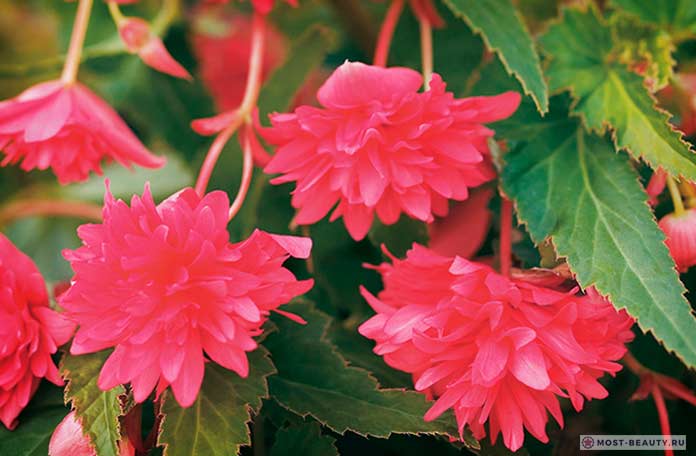

This terry begonia in most catalogs belongs to the number of root varieties and is considered one of the most attractive among them. Long shoots are crowned with beautiful large flowers that can be of different colors. The most impressive varieties of this variety are bright red, scarlet, peach and pink flowers. Belleconia is a street begonia. It is most often grown indoors, but it grows better outdoors. Therefore, it is recommended, as it gets warmer, to transplant the plant into open ground.
4
Care and reproduction
Care
Home begonia does not require special attention. The main concern about it comes down to maintaining the optimal air temperature, timely watering and feeding. Begonia growing outside the home needs to be carried indoors during the winter.
Seeds
Varieties of ever-flowering begonias are grown from seeds. It is they who better convey their varietal characteristics through the seed material. The seeds germinate very well and amicably.
They are sown in early February so that by the onset of autumn, young shoots become strong. They are planted in shallow containers. The sown seeds are not covered with earth, but only slightly pressed against the soil. The boxes are covered with glass or polyethylene and the temperature is left in the room, which does not drop below twenty degrees.
In order to avoid washing out the seeds, watering is done by drip method or using a spray bottle. After a week, they will begin to sprout. After that, the seedlings are gradually accustomed to room temperature, removing the glass and ventilating the containers.
After a month, the begonia seedlings are transplanted into separate compact planters. This must be done with care, since young shoots are very delicate and break easily.
After another month, they are transplanted into permanent pots. These varieties begin to delight with their flowering already in the first year of growth.
Sprouts
Begonia reproduces well with tubers, but small sprouts must be present on them.
Purchased planting material should be placed on a damp cloth as soon as possible. It is necessary to monitor the moisture content of the fabric until the first roots appear on the tubers. Then they can be planted in pots. The top of the tuber should be on the surface.
When the weather becomes warm enough, begonias are planted in the garden, buried in the ground along with the pots. And with the onset of autumn frosts, they bring it home, and cut the stems. The tubers are left in a cool place throughout the winter. At this time, they are not watered. If sprouts appear, the tuber is freed from the soil layer to accelerate growth. And when the plant gives several shoots, it is again covered with earth.
Decorative flowering varieties
Eternal blooming
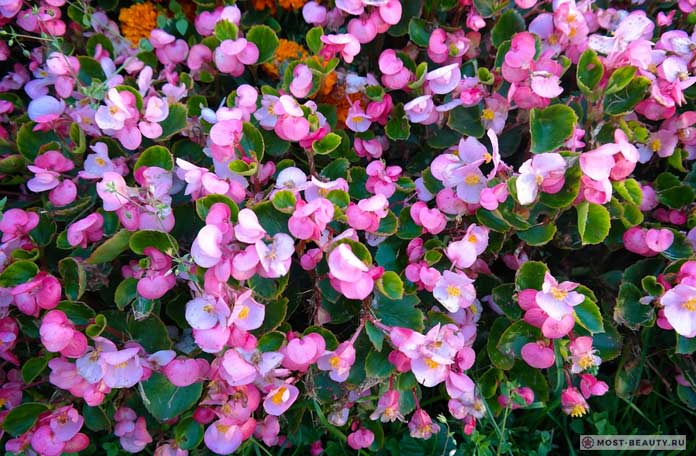

This group includes many varieties of begonias that bloom all summer and are unpretentious to weather conditions. Among the most famous is the impressive variety "Baby Wing" with colorful flowers of various colors.
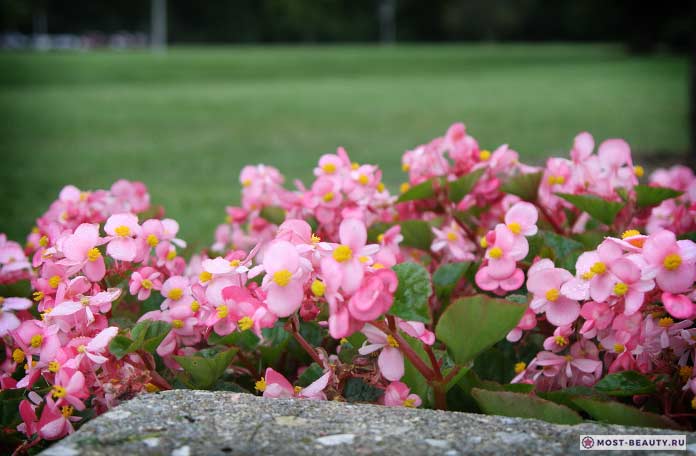

In the photo: variety Baby Wing
“Ambassador” is no less in demand, which includes varieties with green leaves cut along the edges in the form of an original red stripe. Their flowers are impressive in a wide range of colors.
Elatior
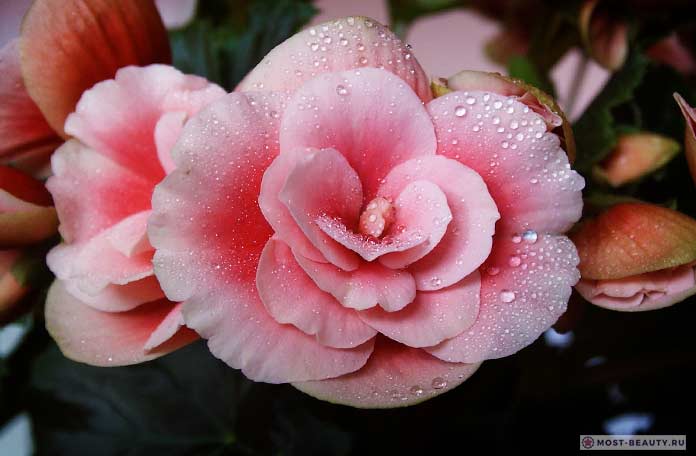

This hybrid variety was developed in England. Such begonia blooms all year round, for which it is called winter. Compact bushes with lush flowers and glossy leaves in the form of an asymmetrical heart with denticles on the edges look beautiful in pots on the windowsill.
Gloire de Lorrain
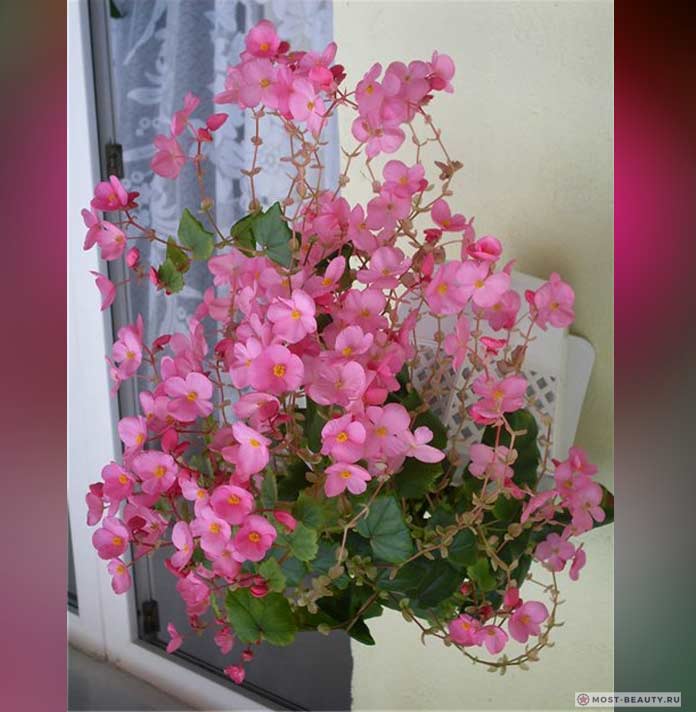

This variety can also bloom not only in autumn but also in winter. The plant is not tall, but very spreading, especially attractive due to drooping brushes of small bright pink flowers.
5
Possible growing problems
When growing red begonias, it is very important to provide proper care before and after planting. Otherwise, the plant can become a victim of pests or various ailments.
Did you know? In 1988, in honor of the friendship between Japan and the People's Republic of Korea, a new variety of begonia "Kimcheniria" was bred by a famous Japanese biologist. A feature of the plant is that it blooms annually on February 16, on the birthday of the leader Kim Jong Il.
Diseases
Failure to comply with the watering and feeding regime, lack of lighting or humidity can provoke the development of various diseases in begonia.
Most often, the culture is susceptible to:
- Gray rot... The disease manifests itself in the form of white spots on the surface of leaves, buds, stems, which later transform into putrefactive areas. Progressing, the disease leads to the fall of flowers, leaves, complete rotting of the branches. To combat the disease, the plant is treated with a solution of soapy water, Bordeaux liquid or store-bought fungicidal preparations.
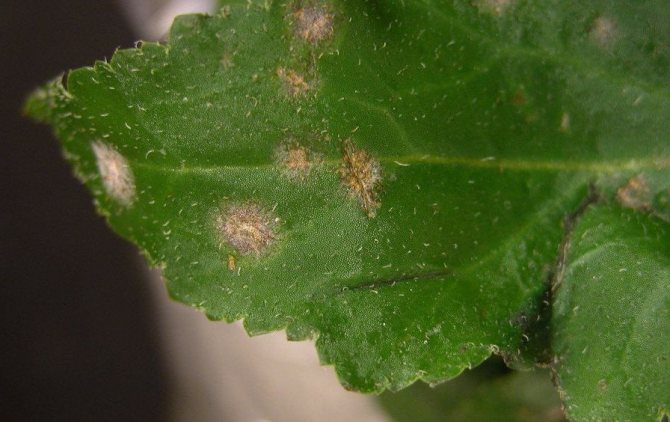

- Powdery mildew... Spots of white color appear on the leaves of the culture, which subsequently completely cover the leaf plate, as a result of which it darkens and dries out. For the treatment of the disease, the foliage is sprayed with a solution of copper sulfate.


- Bacterial spot... The disease described is characterized by watery spots on the underside of the leaf plate. Unfortunately, the disease cannot be treated and if the foliage is damaged, the plant should be destroyed.
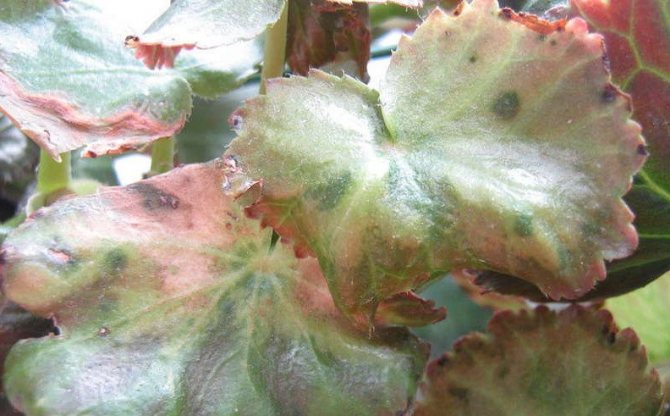

Begonia reacts negatively to any violations of the rules of care:
- with a lack of moisture and dry air, it sheds leaves and flowers;
- with a lack of lighting - the leaves lose their bright color, become faded;
- at low temperatures, it is exposed to gray rot.
Pests
Often, a domestic beauty is attacked by pests and parasites, among which the most dangerous are:
- spider mite - a characteristic white web appears on the foliage;
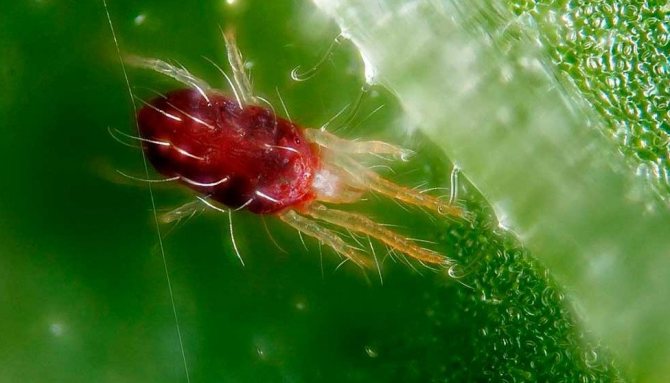

- aphid - a small insect feeds on plant sap, as a result of which the foliage begins to turn yellow and fall off, and the flower stops growing;
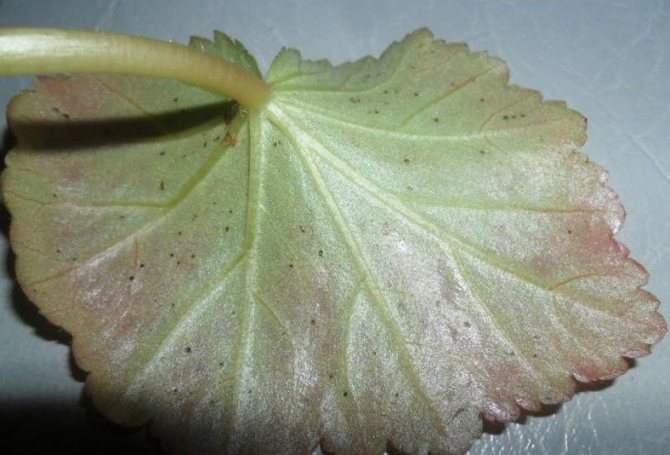

- mealybug - affects the leaves, which first become dry, and then curl into a kind of "tube".
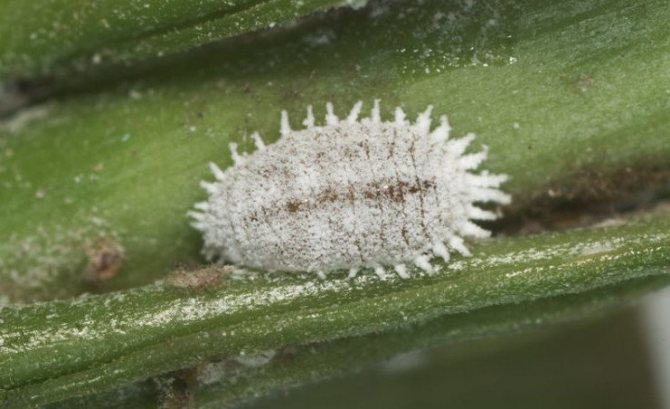

To destroy parasites, it is recommended to treat the plant with modern insecticidal preparations of a wide spectrum of action or to use folk remedies - for example, soap solution.
Red begonia is considered one of the most unusual and beautiful varieties of this decorative culture. Lush, voluminous bright red flowers will appeal to even those who have little interest in indoor plants. And, despite some nuances in care, novice flower growers will be able to grow the described culture on their windowsill without any problems.
Begonia legends and symbols


According to one of the legends of the South American Indians, their goddess of Heaven, Tamaya, turned into a beautiful begonia flower. Descending once a year to earth in the form of a beautiful woman, she was captured by the conquistadors. They wished to take her to Europe, but upon arrival they saw only a dried flower in the hold. The French botanist returned the plant to its homeland, and the Indians were able to revive it. In China, they claim that beautiful begonia flowers arose from the tears of a girl in love.
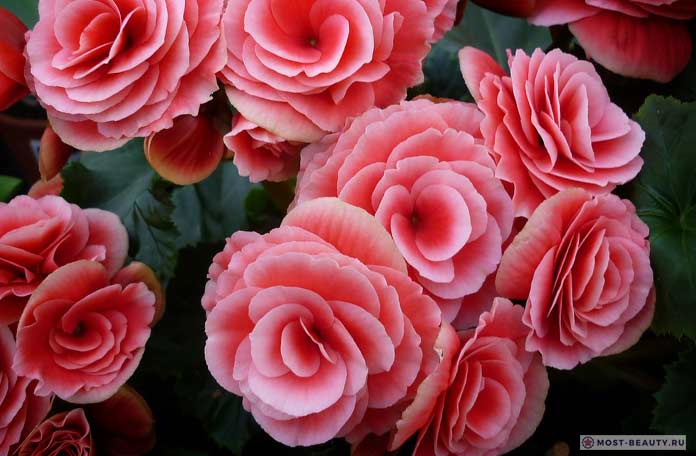

It is believed that these indoor flowers are able to attract happiness, help to find good luck in finances and meet love. Astrologers claim that begonia is under the auspices of the Sun and Venus and is able to relieve blues and depression.
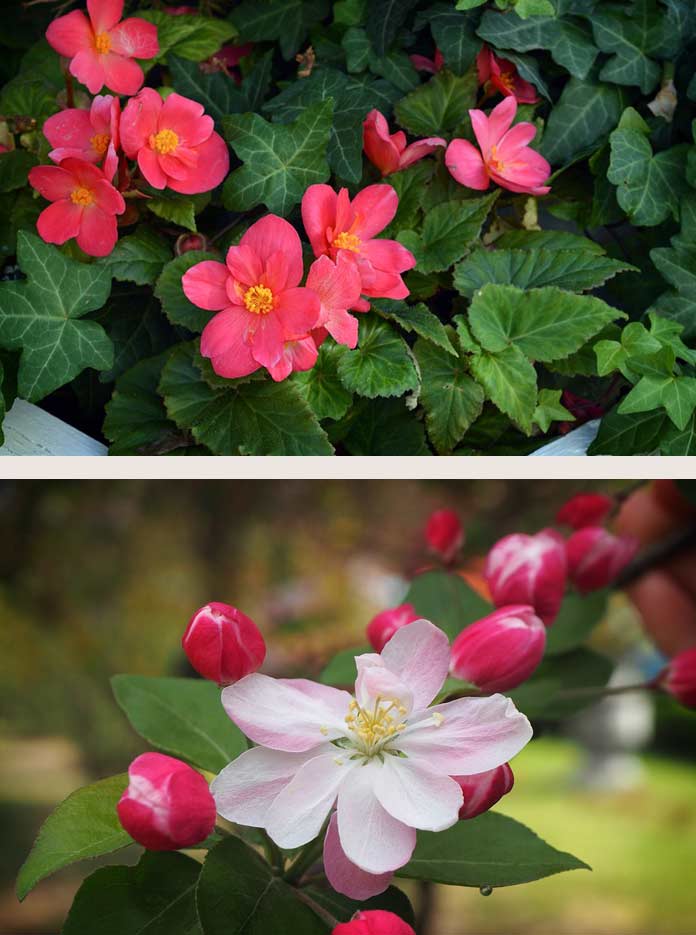

Looking at its many beautiful varieties, it is difficult to disagree with this statement. Bright colors of flowers and original shapes and colors of leaves are pleasing to the eye and tune in to positive.
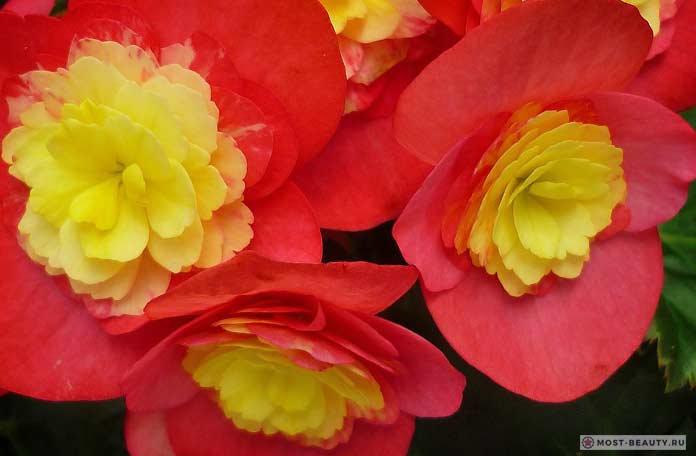

Therefore, beautiful begonias can be safely given as a gift without fear of the negative semantic load of this plant. But it is better to buy them at a flower shop rather than in the markets.
6
Features of begonia


In addition to about 1,000 species existing in nature, there are still about 2,000 hybrids of this plant. In this regard, an average description of this plant simply does not exist. Plus, such plants in various classifications are divided into decorative flowering and decorative deciduous, deciduous and evergreen, perennials and annuals, creeping and tall, rhizome and tuberous. Florists grow a huge variety of begonias at home, and all of them need to be looked after when cultivated at home in about the same way.
Begonia as a useful flower in the house
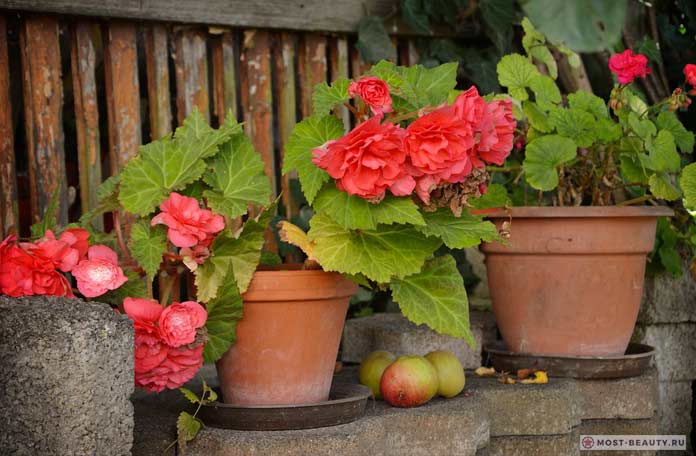

Begonia is an ideal indoor plant for color therapy. Varieties with orange flowers improve mood, relieve blues, and the yellow color of the inflorescences allows tired eyes to relax.
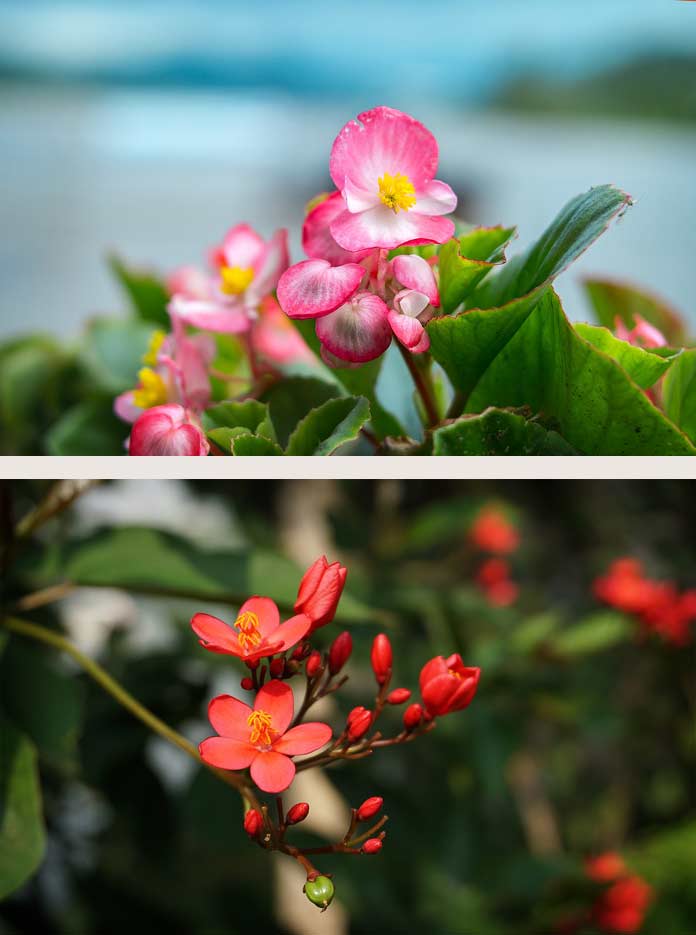

Red begonia adjusts to the positive, adds vitality and strength to achieve the desired goals. In Asia, it is from these flowers that the decoration for the bride is made, which symbolizes a fiery passion that will not fade away in marriage.
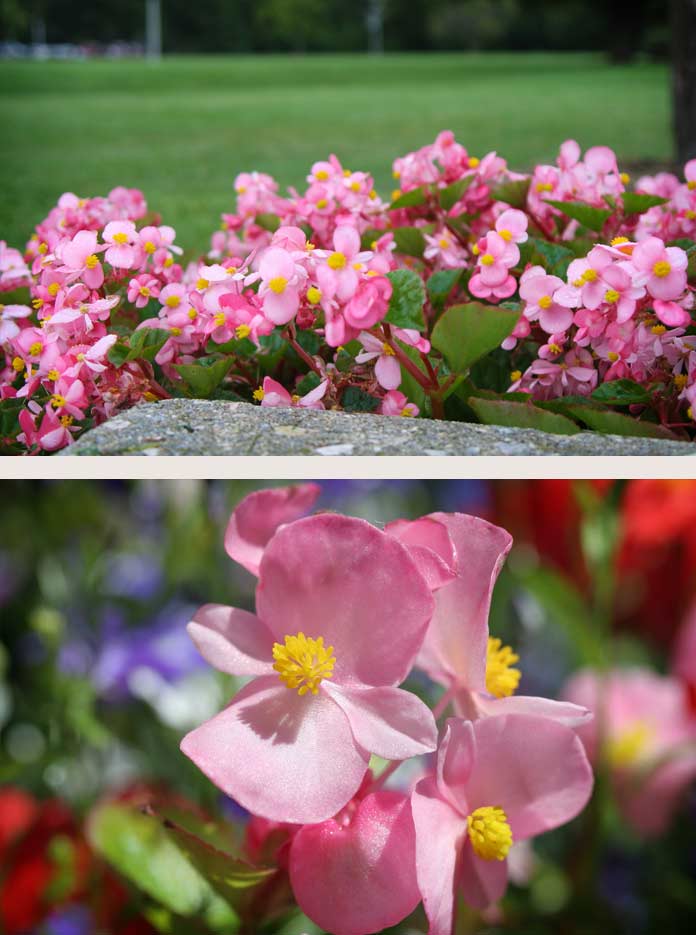

In addition, begonia is considered one of the best indoor plants for indoor air purification. The leaves of this flower absorb dust well. It is also recommended to place the begonia pots near the computer to neutralize harmful radiation.
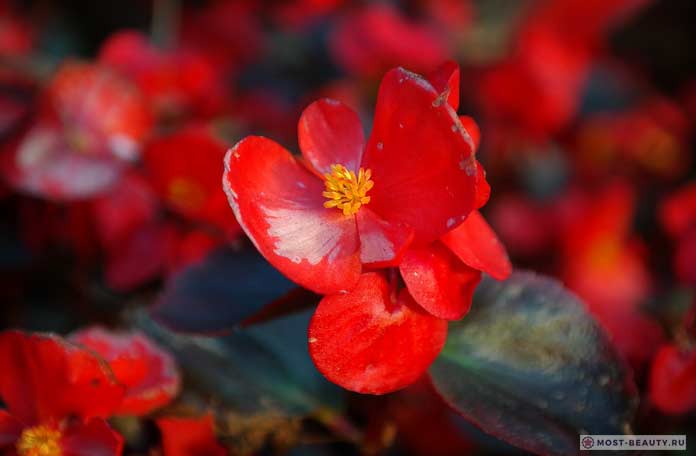

Varieties with red flowers can be placed in the bedroom, and varieties with decorative leaves should be chosen to decorate the kitchen.
7
Flower care
Caring for begonias at home is easy and simple. Good lighting and the absence of direct sunlight are important for this plant. The most comfortable temperature for a flower is 18 ° C.
Landing
Euphorbia flower - types and popular varieties
It is better to plant in spring, at the end of March. Planting in open ground is carried out at the end of March, so as not to freeze the plant. For this species, it is recommended to choose larger pots. One third of them need to be filled with a drainage layer of expanded clay, coal or shells.
The soil
It is best to use slightly acidic soil (pH = 5.5-6.5), consisting of peat, leafy and sod land, and coarse river sand.
Note! To increase the acidity of the soil, add the calcined soil of coniferous trees.
Watering
Begonia is a tropical plant, so it is necessary to provide sufficient indoor air humidity (60-70%) to prevent the leaves from drying out. It is recommended to water when the top layer of the earth dries out to a depth of 1-2 cm. In summer, the plant needs more frequent and abundant watering. Before that, the water is defended for a day.
Reproduction
Reproduction is done in four ways.
- Seeds. You need to germinate seeds at the end of January, spreading them on the surface of the earth, without sprinkling them. The seed pot is placed in a warm, well-lit room, you can put it under a lamp and cover with foil. After the appearance of four sheets, a pick is made. Two months after sowing the seeds, the seedlings are transplanted into individual pots.
- Cuttings. This method is recommended to propagate at the beginning of summer. Twigs with 3-4 leaves are cut from the bush and placed in a container with water until the roots appear. This will happen in about a month. You can also immediately plant the cuttings in the ground and moisten the soil when it dries up by 1 cm.
- By dividing the tuber. This method is propagated in the spring. The plant is pulled out of the ground and the tuber is divided into several parts. Each section must have roots. The tubers are planted in separate pots.
- Sheet. Both whole leaves and parts of them are suitable for reproduction. The main veins are cut on them and placed in the calcined soil. Water the sheets through the pallet.
Tuberous begonias (Tuberous Begonias)
Tuberous begonia varieties B. x tuberhybrida (including ampelous B. tuberhybrida pendula), multiflorous (B. multiflora), B. sutherlandii (Sutherland begonia); B. x elatior (Elatior groups), B. x Lorrain (Lorrain groups). Photos with the names of individual varieties and hybrids.
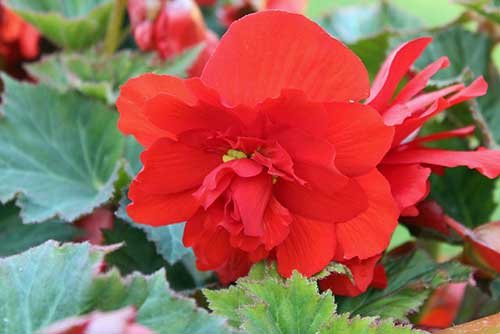

Photo: tuberous begonia 'Superba-Scarlet' - terry bright red ...
Begonias are grown because of their incredibly beautiful flowers, ranging in size from 1.5 cm to larger sizes. Terry, camellia-like, flowers similar to a beautiful rose, with a contrasting edge and a simple shape of petals: yellow, red, white, orange, pink, some with a smell.
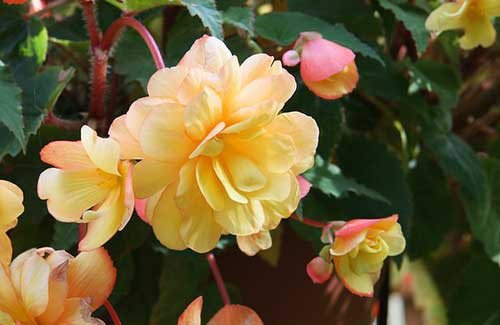

Begonia x tuberhybrida (tuberous) ...
There are types and varieties of begonias with interesting leaves and appearance in general. Some grow vertically upward, others - ampelous, with hanging stems. A thick tuberous rhizome from which stems grow. Tuber - tuber (eng.)
The varieties of the popular group Elatior (B. x elatior) and the rather rare group of Lorrain (B. x Lorrain) can be classified as winter flowering varieties.
Tubers and characteristic caudex thickenings do not form or die off for the winter. They are assigned to this group solely because of the pedigree. They are not very durable, every few years they are renewed by rooting cuttings.
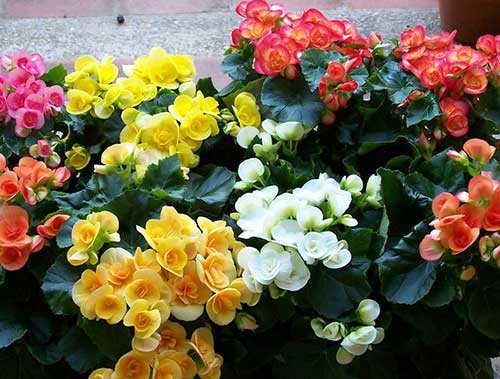

Lorraine (B. x lorraine) - according to the classification refers to the tuberous begonias of the Сheimantha group (Begonia x сheimantha).
Elatior (B. x elatior) - according to the classification of varieties, it belongs to the tuberous begonias of the Hiemalis group - winter begonia (Begonia x hiemalis).
The common parent for these groups (Elatior and Lorrain) was the Socotran begonia (Begonia socotrana). The plant does not lose its beauty for many months, it is easily restored and sets new buds -
B. tuberhybrida pendula (pendula) - ampelous tuber hybrid ...

